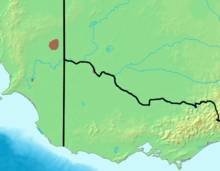Black-eared miner
| Black-eared miner | |
|---|---|

| |
| Scientific classification | |
| Kingdom: | Animalia |
| Phylum: | Chordata |
| Class: | Aves |
| Order: | Passeriformes |
| Family: | Meliphagidae |
| Genus: | Manorina |
| Species: | M. melanotis
|
| Binomial name | |
| Manorina melanotis (, 1911)
| |

| |
| Distribution of the black-eared miner | |
The black-eared miner (Manorina melanotis) is an endangered honeyeater endemic to mallee woodland in south-eastern Australia.
Taxonomy[]
It is closely related to the much more widely distributed yellow-throated miner M. flavigula, and the taxonomic status of the black-eared miner is the subject of some controversy, with some researchers considering it a subspecies of M. flavigula.
Behaviour[]
Black-eared miners are co-operative breeders, living in colonies during the breeding season, and dispersing into the bush during non-breeding periods. Little is known of their movements during these periods.
Distribution and habitat[]
IBA (Important Bird and Biodiversity Areas), identified by BirdLife International as being important for black-eared miner conservation, are areas containing relatively intact, mallee woodland in north-western Victoria and south-eastern South Australia. They comprise Murray-Sunset, Hattah and Annuello, the Riverland Mallee, and Wyperfeld, Big Desert and Ngarkat.[2]
Conservation status[]
Black-eared miners are listed as endangered on the Australian Environment Protection and Biodiversity Conservation Act 1999.[3]
The species' conservation status in several Australian states follows:
- New South Wales: Listed as "Critically Endangered" by the Threatened Species Conservation Act 1995, as of May 2015.[3]
- South Australia: Listed as "Endangered" by the National Parks and Wildlife Act 1972, as of June 2011.[3]
- Victoria: Listed as "Threatened" by the Flora and Fauna Guarantee Act (1988), as of April 2015, and as "endangered" on the 2007 advisory list of threatened vertebrate fauna.[4][5] Under this Act, an Action Statement for the recovery and future management of this species has been prepared.[6]
See also[]
References[]
- ^ BirdLife International (2016). "Manorina melanotis". IUCN Red List of Threatened Species. 2016: e.T22704441A93968828. doi:10.2305/IUCN.UK.2016-3.RLTS.T22704441A93968828.en. Retrieved 12 November 2021.
- ^ "Black-eared Miner". Important Bird Areas. BirdLife International. 2012. Archived from the original on 10 July 2007. Retrieved 2012-11-04.
- ^ a b c "Manorina melanotis — Black-eared Miner". Australian Government, Department for the Environment. Retrieved 4 October 2015.
- ^ Victorian Department of Sustainability and Environment (2007). Advisory List of Threatened Vertebrate Fauna in Victoria - 2007. East Melbourne, Victoria: Department of Sustainability and Environment. p. 15. ISBN 978-1-74208-039-0.
- ^ Department of Sustainability and Environment, Victoria Archived 18 July 2005 at the Wayback Machine
- ^ Department of Sustainability and Environment, Victoria Archived 11 September 2006 at the Wayback Machine
External links[]
| Wikimedia Commons has media related to Manorina melanotis. |
| Wikispecies has information related to Manorina melanotis. |
- BirdLife Species Factsheet
- Photos and audio of black-eared miner from Cornell Lab of Ornithology's Macaulay Library
- Recordings of black-eared miner from Graeme Chapman's sound library
- IUCN Red List endangered species
- Manorina
- Birds of South Australia
- Birds of Victoria (Australia)
- Endemic birds of Australia
- Endangered fauna of Australia
- Birds described in 1911
